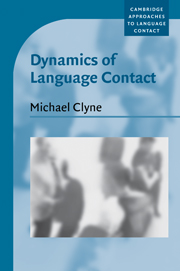Book contents
- Frontmatter
- Contents
- List of map and figures
- List of tables
- Series editor's foreword
- Acknowledgments
- List of abbreviations
- 1 Introduction
- 2 Dynamics of language shift
- 3 On models and terms
- 4 Dynamics of convergence and transference
- 5 Dynamics of transversion
- 6 Dynamics of plurilingual processing
- 7 Dynamics of cultural values in contact discourse
- 8 Towards a synthesis
- Notes
- References
- Index of authors
- Index of languages
- Index of subjects
2 - Dynamics of language shift
Published online by Cambridge University Press: 18 December 2009
- Frontmatter
- Contents
- List of map and figures
- List of tables
- Series editor's foreword
- Acknowledgments
- List of abbreviations
- 1 Introduction
- 2 Dynamics of language shift
- 3 On models and terms
- 4 Dynamics of convergence and transference
- 5 Dynamics of transversion
- 6 Dynamics of plurilingual processing
- 7 Dynamics of cultural values in contact discourse
- 8 Towards a synthesis
- Notes
- References
- Index of authors
- Index of languages
- Index of subjects
Summary
Introduction
In this chapter, we are dealing with the macrolevel of language. In order to discuss the structural changes that occur in an immigrant language, we need to see the changes as part of a process of gradual, slower or more rapid shift from one language to another. In the present chapter, Australian data will be used to illustrate the dynamics of language shift from immigrant languages to English. Some of the data that I will be studying is based on responses to the same census question at the same time (though not at the same time of people's migration history) in the same places. An attempt will also be made to view similar sets of data diachronically. In particular, this chapter will consider some of the factors promoting or impeding language shift and influencing the differential shift rates in different ethnolinguistic communities. This data will be supplemented by studies of language use patterns. Various models will be considered to explain processes and mechanisms of language shift in the context of place, time and community. This is the field that owes much of its development to the innovative work of Joshua Fishman.
First let us elucidate the meanings that are given to ‘language shift’.
It can refer to the language behaviour of a whole community, a sub-group within it, or an individual.
It can mean a gradual process, a ‘shifting’, as has been described for the replacement of Hungarian by German in Oberwart in the Austrian state of Burgenland (Gal 1979). However, it can also mean that a language previously employed by an individual or group is no longer used at all by them.
[…]
- Type
- Chapter
- Information
- Dynamics of Language ContactEnglish and Immigrant Languages, pp. 20 - 69Publisher: Cambridge University PressPrint publication year: 2003

